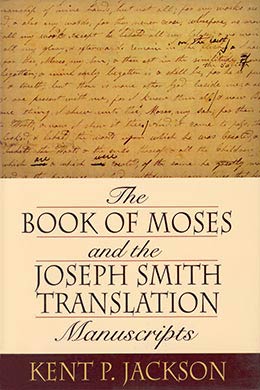Moses 1-8
Kent P. Jackson, The Book of Moses and the Joseph Smith Translation Manuscripts (Provo: Religious Studies Center, Brigham Young University, 2005), 143–144.
The following transcript of the Book of Moses is the text as Joseph Smith left it to the Church and as recorded on the original manuscripts. In transcribing this text, I have adhered to the following two guidelines:
1. The text is as Joseph Smith dictated it to his scribes. This includes (a) the Old Testament Manuscript 1 text and (b) later corrections he made to the text, recorded by him and his scribes on both Old Testament Manuscript 1 and Old Testament Manuscript 2. [1]
2. Grammar, spelling, capitalization, and punctuation have been standardized to current usage. [2]
In the preparation of the Manuscript Text, there has been no effort made to select a favored reading or to pick and choose among alternatives. There has been no consideration given to familiar or established readings, nor to doctrinal implications. This is simply the text that Joseph Smith prepared on the original manuscripts of his New Translation of the Bible, without the changes that were made in subsequent years by copyists, editors, and typesetters. The words are presented as the Prophet left them, but with grammar, spelling, capitalization, and punctuation standardized. Only in the area of punctuation was subjective judgment necessary on a few occasions. But even then, punctuation decisions infrequently have implications for how the text is understood. For convenience, the verse numbers of the current Book of Moses have been inserted, but no paragraphing has been added.
The Manuscript Text was not prepared to be an alternative to the text contained in the Pearl of Great Price. Its intent is simply to show the results of an examination into the history of the Selections from the Book of Moses. The text brings us as close as is now possible to the book’s original revelation and to the Prophet who brought it forth. In doing so, it bears testimony both to the message and to Joseph Smith’s calling to reveal it to the world.
Notes
[1] Transcription anomalies made by John Whitmer on Old Testament Manuscript 2 that were incorporated later into revisions by Joseph Smith are preserved in the Manuscript Text.
[2] Almost all of the standardization was accomplished by John Whitmer and the compilers of the editions. For example, “These words was spoken” (Moses 1:42; OT1) is changed to “These words were spoken” (OT2). The use of archaic language, however, has not been standardized in this text. Like the Book of Mormon, the Book of Moses shows fluidity in the use of archaic and modern personal pronouns (thee, thou, ye, you), possessive pronouns (my, mine), and associated verbal conjugations. Joseph Smith dictated both thou/
